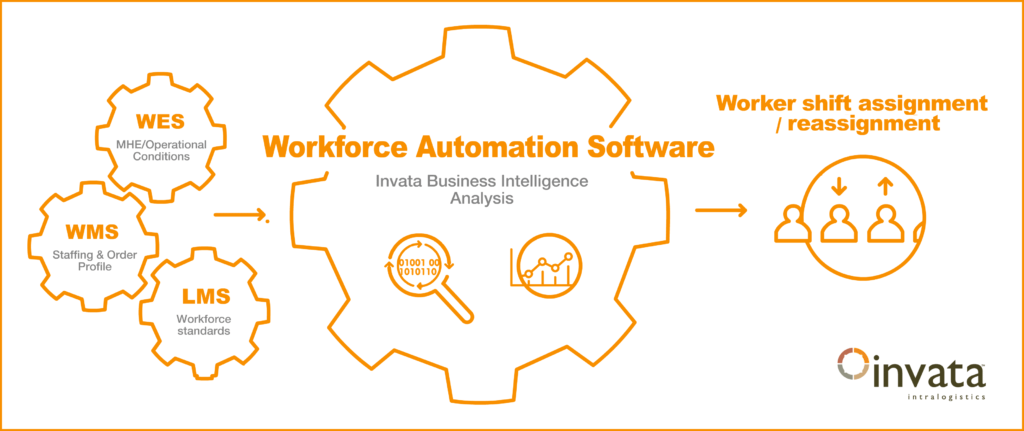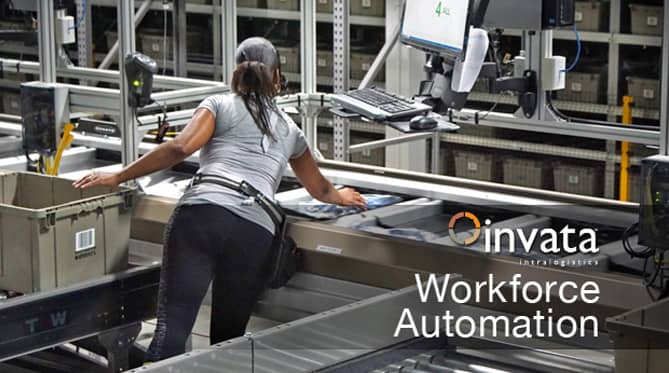What’s the next logical advancement in warehouse automation software?
It’s using real-time operational analysis combined with historical worker performance metrics to automate the process of determining how, when, and where workers are assigned in a fulfillment operation.
To date, warehouse automation has been focused on controlling material handling equipment and fulfillment processes, but has left the control of workers primarily in the hands of warehouse managers. That’s about to change.
The proper assignment and distribution of warehouse labor is essential to the synchronized flow of materials and orchestration of process in an automated warehouse.
The performance of upstream activities such as picking can impact the efficiency of downstream activities such as induction — not to mention the utilization of material handling equipment for sortation, packing, and labeling — and vice versa. Complicating that are the frequent fluctuations in order volumes and order types inherent to e-commerce and omnichannel fulfillment today. When those fluctuations occur, workers often need to be shifted to different work stations or to different tasks in order to maintain operational performance.
Given the fast pace of automated order fulfillment and the intricate interplay of workers and machines involved, it’s hard for any manager, no matter what their experience, to see the big picture for labor deployment as events are unfolding, let alone spot bottlenecks before they happen.
Workforce automation software, on the other hand, can identify the areas or tasks that need the most labor support and determine which workers from the available worker pool can be assigned/reassigned to areas in need of support. And it can do so based on an analysis of each worker’s skills, experience, and performance levels.
By proactively managing potential bottlenecks and rebalancing personnel to maintain operational workflow on a real-time basis, workforce automation software maximizes labor resources for operational efficiency and ensures that an order fulfillment operation meets service level agreements.
A New Level of Software Functionality
Workforce automation requires functionality not currently found in warehouse software applications.
Warehouse Management software (WMS) can be used to determine the pick path for pickers, but it does not assign workers to tasks like picking, let alone reassign workers to completely different tasks based on need.
Warehouse Execution Software (WES) can direct machines as well as workers, but it still leaves work assignments to managers.
And Labor Management Software (LMS) can be used to measure an individual worker’s activity against preset labor standards, but it does not use those assessments to make warehouse staff assignments.
Bottom line, managers still have to assign workers to specific tasks and determine the extent to which an individual’s past task-specific performance should factor into his or her specific shift assignment.
Scheduling personnel for daily and weekly shifts in a warehouse operation is often done by managers using Workforce Management (WFM) software. But as a rule the WFM receives no information from the LMS for use in determining personnel assignments. Nor does the WFM receive input from a WMS or WES in regard to the status of a fulfillment operation to make automatic, on-the-spot reassignments of laborers to particular areas of the operation in need of help.
An Integrated, Intelligent Solution
MSI Automate’s Workforce Automation, on the other hand, brings together information from traditionally siloed software applications to provide the basis for making smart labor assignments.
Because MSI Automate’s Workforce Automation software can be integrated with our own WMS, LMS, and WES applications or those of other companies, it has access to the kind of a records and event transaction logs that enable it to garner a complete, up-to-the-second picture of the status of any fulfillment operation while also having access to historical worker performance data.

MSI Automate’s Workforce Automation software also leverages the business intelligence (BI) capabilities available in an MSI Automate solution, which uses a BI engine to analyze real-time operational data and identify potential bottlenecks as well as areas of the fulfillment operation that might potentially perform under par. That analysis provides the basis for determining both the tasks and the locations to which laborers should be assigned to ensure a steady workflow.
Work Assignments by Algorithm
Algorithms in the MSI Automate Workforce Automation software determine the tasks to which workers from each shift will be assigned. In making those assignments, logic in the algorithms is used to assess the performance metrics of each worker on the shift (found in the MSI Automate LMS) to ensure that each assignment will yield the most efficient results and that the fulfillment operation adheres to service level commitments.
Each worker is rated on every task and assigned a skill and throughput score based on historical performance and ranked in comparison to his/her peers.
At the start of each work shift, the algorithms match personnel to a specific task such as picking, packing, putaway, receiving, and reslotting based on their performance ranking and the availability of workers.
During the course of an operation, the algorithms periodically rebalance the workforce and reassign workers based on the analysis from the MSI Automate BI engine of order fulfillment progress, current staffing levels, operating conditions, and changes in priorities.
In doing so, MSI Automate’s Workforce Automation software, not only lessens the workload for warehouse managers, but brings strategic competitive advantage to MSI Automate clients by ensuring the same level of efficiency in the workforce that was previously only achievable in the material handling equipment.
Complete Warehouse Automation
By enabling worker assignments to be determined by the same sophisticated software that manages the massive complexities of an automated fulfillment operation, MSI Automate’s Workforce Automation software fills a gap in warehouse automation that has existed to date.
Using a combination of algorithms, business intelligence, performance analytics, and a unified cross-application database, MSI Automate’s Workforce Automation software ensures that the right workers from each shift’s available pool are matched to the right tasks, so the fulfillment operation can perform at the highest level of efficiency in filling orders and meeting customer commitments.
To schedule a free appointment to discuss your workforce needs, contact us here.
Walter High is VP Marketing at MSI Automate, where he has worked since 2012.

